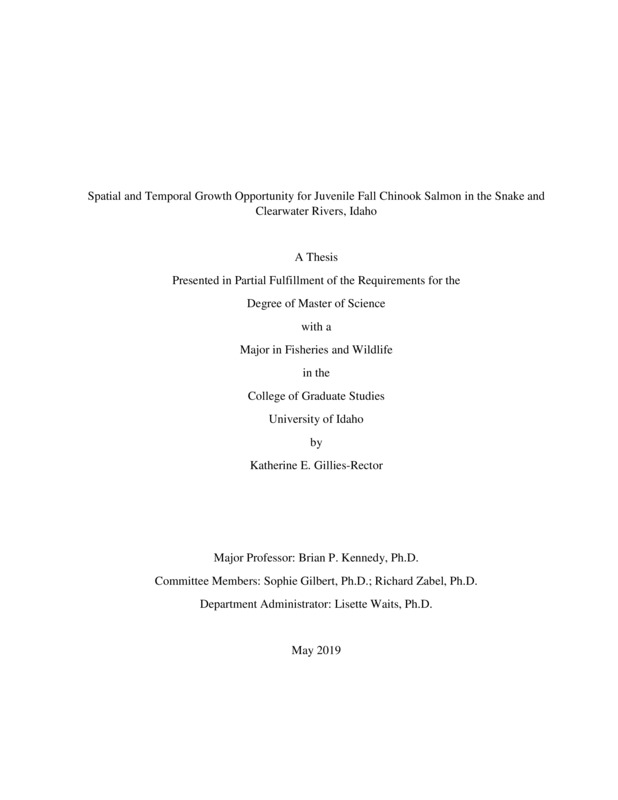Spatial and Temporal Growth Opportunity for Juvenile Fall Chinook Salmon in the Snake and Clearwater Rivers, Idaho
Gillies-Rector, Katherine. (2019-05). Spatial and Temporal Growth Opportunity for Juvenile Fall Chinook Salmon in the Snake and Clearwater Rivers, Idaho. Theses and Dissertations Collection, University of Idaho Library Digital Collections. https://www.lib.uidaho.edu/digital/etd/items/gilliesrector_idaho_0089n_11547.html
- Title:
- Spatial and Temporal Growth Opportunity for Juvenile Fall Chinook Salmon in the Snake and Clearwater Rivers, Idaho
- Author:
- Gillies-Rector, Katherine
- ORCID:
- 0000-0001-9566-2813
- Date:
- 2019-05
- Embargo Remove Date:
- 2020-07-08
- Keywords:
- Bioenergetics Fisheries Life History Stable Isotopes
- Program:
- Natural Resources
- Subject Category:
- Natural resource management
- Abstract:
-
Understanding the conditions that produce diverse salmonid migration strategies is challenging in a large river network where life history trajectories arise from multiple biotic and abiotic factors. Because early growth is closely linked to migration initiation, identifying the growth conditions experienced by individual fish at a small time scale is crucial. Here, we paired a long-term otolith dataset with a detailed bioenergetic assessment of early growth opportunity in a population of Chinook salmon to identify how growth conditions related to migration initiation. In the Snake river population of fall Chinook salmon, juveniles historically migrated their first summer, but in recent years an overwintering migration strategy has emerged. Using otolith microchemistry and microstructure analysis, we determined that a significant proportion of fish from both the Clearwater and Snake rivers overwinter and migrate the following spring. Notably, Clearwater origin fish that migrated as yearlings performed a larger proportion of their freshwater growth in natal habitat than Snake origin fish. We also found higher growth and consumption during the early growth period for fish originating in the Snake river and downstream reservoir compared to the Clearwater river, by comparing relative growth and consumption using a daily time-step bioenergetics model. The combined bioenergetics and migration analysis demonstrates that while both Snake river and Clearwater origin fish express the overwintering strategy, their relative growth in natal habitats differ. These findings suggest that the yearling migration strategy may arise from different conditions throughout the population, though the net effect is the increasing prevalence of this strategy.
- Description:
- masters, M.S., Natural Resources -- University of Idaho - College of Graduate Studies, 2019-05
- Major Professor:
- Kennedy, Brian P
- Committee:
- Zabel, Richard; Gilbert, Sophie
- Defense Date:
- 2019-05
- Identifier:
- GilliesRector_idaho_0089N_11547
- Type:
- Text
- Format Original:
- Format:
- application/pdf
- Rights:
- In Copyright - Educational Use Permitted. For more information, please contact University of Idaho Library Special Collections and Archives Department at libspec@uidaho.edu.
- Standardized Rights:
- http://rightsstatements.org/vocab/InC-EDU/1.0/

